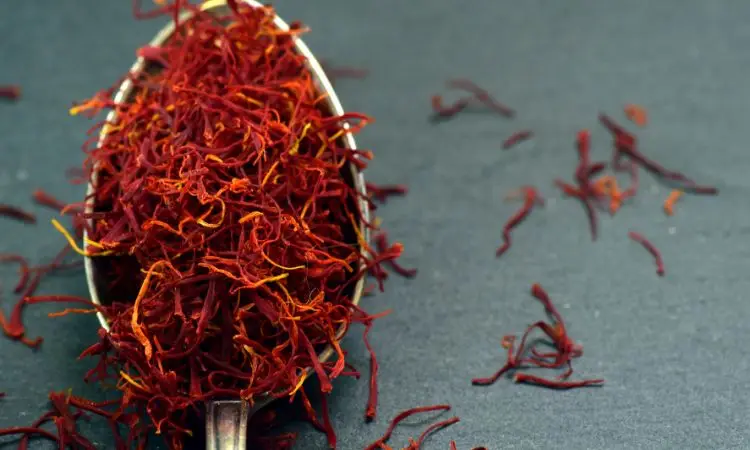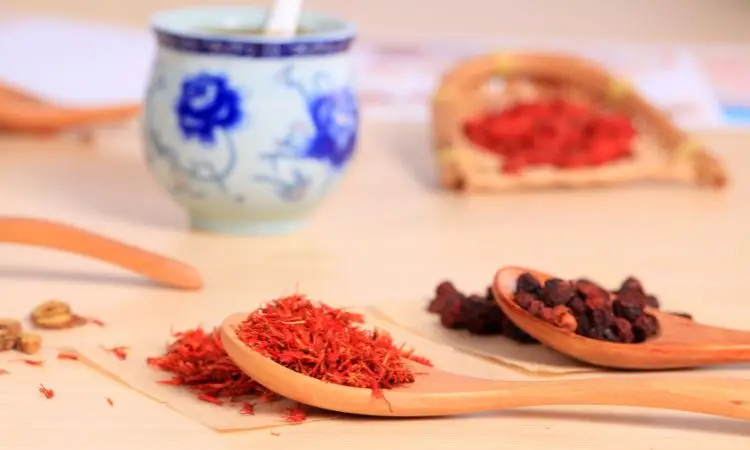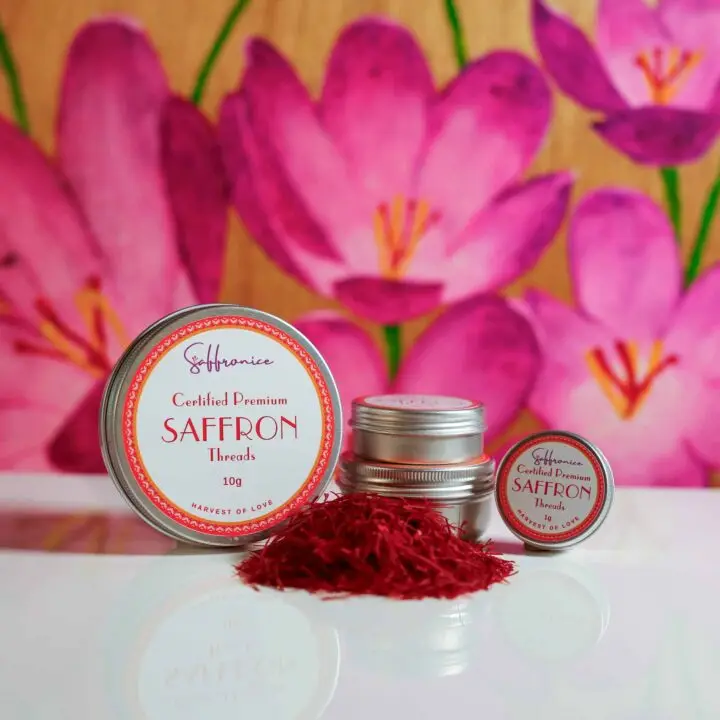📌 Quick Answer: Saffron (Crocus sativus) has been integral to Traditional Chinese Medicine for over 2,000 years, used to regulate Qi (vital energy), treat depression, support liver function, and enhance spiritual awareness. Modern research validates its effectiveness for mood disorders, inflammation, and eye health, aligning perfectly with traditional TCM applications.
Historical Foundations in TCM {#historical-foundations}
Traditional Chinese Medicine’s relationship with saffron extends back over two millennia, with the precious spice first documented in classical medical texts during the Han Dynasty. The earliest recorded mention appears in Shennong’s Great Herbal (Shennong Ben Cao Jing), compiled between 300-200 BC, where saffron was classified as a superior herb capable of harmonizing vital energy without adverse effects.
Food Scientist’s Historical Perspective: The integration of saffron into Chinese medicine represents a fascinating convergence of botanical science and energetic healing principles. Unlike Western pharmacology’s focus on isolated compounds, TCM recognizes saffron’s holistic influence on multiple body systems simultaneously.
The Chinese name for saffron, “fan hong hua” (藏红花), literally translates to “foreign safflower,” reflecting its origins along the ancient Silk Road trade routes. Persian merchants introduced this golden treasure to Chinese courts, where it quickly gained recognition among imperial physicians for its remarkable ability to regulate Qi (vital energy) and blood circulation.
Cross-Cultural Integration Patterns
The adoption of saffron into Chinese medical practice illustrates the sophisticated understanding ancient Chinese physicians had of botanical medicine. Rather than simply adopting Persian or Greek applications, Chinese doctors carefully observed saffron’s effects within their existing theoretical framework, ultimately developing unique therapeutic protocols that remain relevant today.
Key historical applications included:
- Imperial court medicine: Reserved for treating royal family members’ emotional imbalances
- Monastery healing: Buddhist monks used saffron for meditation enhancement and spiritual clarity
- Scholar’s remedy: Literati employed saffron to sharpen mental faculties during examinations
- Women’s health: Specialized formulations for menstrual regulation and reproductive wellness
Understanding this ancient medicine context provides crucial insight into saffron’s enduring significance in contemporary TCM practice.

Botanical Profile and Active Compounds {#botanical-profile}
Crocus sativus: Nature’s Pharmaceutical Laboratory
The saffron crocus (Crocus sativus) represents a remarkable example of nature’s concentrated healing potential. Each delicate purple flower produces only three crimson stigmas, requiring approximately 150 blooms to yield just one gram of saffron – a ratio that partly explains both its precious nature and concentrated therapeutic potency.
Cultivation and Harvesting Wisdom:
- Timing precision: Flowers bloom for only 2-3 weeks annually, requiring immediate harvest
- Hand-picking requirement: Each stigma must be individually removed within hours of blooming
- Climate specificity: Optimal production requires specific temperature and rainfall patterns
- Soil conditions: Well-draining, slightly alkaline soils produce the highest-quality saffron
Primary Bioactive Constituents
Modern analytical chemistry has identified over 150 chemical compounds in saffron, with four primary constituents responsible for its therapeutic effects:
Crocin (25-30% of total carotenoids):
- Provides saffron’s characteristic golden color
- Water-soluble carotenoid with exceptional bioavailability
- Primary compound responsible for antioxidant properties
- Crosses the blood-brain barrier effectively for neurological benefits
Safranal (0.4-1.3% of volatile oils):
- Creates saffron’s distinctive aroma and taste
- Acts as a natural sedative and anxiolytic compound
- Modulates neurotransmitter systems, including GABA and serotonin
- Contributes to mood regulation effects
Picrocrocin (4-6% of dry weight):
- Responsible for saffron’s characteristic bitter taste
- Precursor compound that converts to safranal during drying
- Enhances digestive function and appetite stimulation
- Supports liver detoxification pathways
Crocetin (0.6-1.0% of total content):
- A fat-soluble carotenoid with high tissue penetration
- Provides cardiovascular protective effects
- Supports cellular energy production and mitochondrial function
- Enhances oxygen transport and utilization
TCM Energetic Properties
From a Traditional Chinese Medicine perspective, saffron’s chemical complexity translates into sophisticated energetic actions:
- Nature (Xing): Neutral with slight cooling tendency
- Taste (Wei): Sweet and slightly bitter
- Meridian Affinity: Heart, Liver, and Kidney systems
- Therapeutic Category: Blood-invigorating and Qi-regulating herb
Traditional Therapeutic Applications {#traditional-applications}
Primary Condition Categories in TCM
Traditional Chinese Medicine employs saffron across multiple therapeutic categories, each addressing specific patterns of energetic imbalance:
Emotional and Mental Health Applications
Depression and Anxiety (Heart-Shen Disturbance): TCM recognizes depression as primarily involving Heart-Shen (spirit) imbalance, often accompanied by Liver Qi stagnation. Saffron’s ability to “open the heart orifices” and regulate emotional flow makes it particularly valuable for treating what modern medicine calls mood disorders.
Traditional Formulation Example:
- Saffron: 0.5-1g daily
- Combined with: Gan Mai Da Zao Tang base formula
- Treatment duration: 4-6 weeks minimum
- Expected outcomes: Improved emotional stability, better sleep, increased energy
Modern research validates this traditional application, with studies showing saffron’s effectiveness comparable to conventional antidepressants for depression treatment with significantly fewer side effects.
Women’s Health and Gynecological Support
Menstrual Irregularities (Blood Stasis Pattern): TCM theory attributes many menstrual problems to blood stasis – a condition where blood circulation becomes sluggish or blocked. Saffron’s blood-invigorating properties make it a primary herb for regulating menstrual cycles and reducing associated discomfort.
Clinical Applications:
- Amenorrhea (missed periods): Saffron moves stagnant blood to restore natural flow
- Dysmenorrhea (painful periods): Reduces cramping through improved circulation
- Irregular cycles: Harmonizes Liver Qi to regulate hormonal fluctuations
- PMS symptoms: Addresses emotional and physical manifestations
For comprehensive information on gynecological applications, consult our detailed guide on women’s health benefits.
Dermatological Applications
Skin Disorders (Heat and Blood Stasis Patterns): Traditional Chinese Medicine views many skin conditions as manifestations of internal heat combined with blood stagnation. Saffron’s cooling properties and blood-moving actions address both root causes simultaneously.
Therapeutic Applications:
- Acne and inflammatory skin conditions: Clears heat and reduces inflammation
- Eczema and dermatitis: Nourishes blood and moistens dryness
- Age-related skin changes: Promotes blood circulation for a healthy complexion
- Wound healing: Accelerates tissue repair through improved circulation
Research supports these traditional uses, demonstrating saffron’s effectiveness for various skin benefits through both topical application and internal consumption.
Digestive System Support
Liver Function Enhancement (Liver Qi Stagnation): TCM recognizes the liver as responsible for smooth Qi flow throughout the body. When liver function becomes compromised, multiple systems suffer. Saffron’s liver-supporting properties help restore optimal function and energy flow.
Traditional Indications:
- Poor digestion: Enhances stomach Qi and promotes proper food transformation
- Emotional eating patterns: Regulates liver Qi to reduce stress-related food cravings
- Fatigue after meals: Supports spleen-stomach harmony for better energy production
- Irritability and frustration: Smooths liver Qi to improve emotional balance
Modern Scientific Validation {#scientific-validation}
Research Alignment with Traditional Applications
Contemporary scientific research increasingly validates Traditional Chinese Medicine’s historical use of saffron, providing molecular mechanisms that explain ancient observations about its therapeutic effects.
Neurological and Psychiatric Benefits
Depression and Anxiety Research: Multiple randomized controlled trials demonstrate saffron’s effectiveness for treating mild-to-moderate depression, with efficacy comparable to conventional antidepressants but significantly fewer side effects.
Key Study Findings:
- Iranian Journal of Medical Sciences: 30mg daily saffron extract showed equal effectiveness to 20mg fluoxetine for depression treatment
- Duration of effect: Therapeutic benefits typically appear within 2-4 weeks of consistent use
- Safety profile: No significant adverse effects reported in therapeutic doses
- Mechanism of action: Modulates serotonin, dopamine, and norepinephrine neurotransmitter systems
Hepatoprotective Properties
Liver Protection Research: Modern studies confirm saffron’s traditional use for liver support, demonstrating significant protective effects against various toxins and inflammatory conditions.
Research Highlights:
- Antioxidant activity: Crocin and crocetin provide powerful free radical scavenging
- Anti-inflammatory effects: Reduces liver inflammation markers significantly
- Regenerative support: Promotes healthy liver cell regeneration and repair
- Detoxification enhancement: Supports optimal liver detoxification pathways
Cardiovascular Benefits
Heart Health Validation: Traditional Chinese Medicine’s classification of saffron as a heart-supporting herb finds strong support in cardiovascular research demonstrating multiple protective mechanisms.
Clinical Evidence:
- Cholesterol management: Significant reductions in total and LDL cholesterol levels
- Blood pressure regulation: Mild hypotensive effects supporting cardiovascular health
- Arterial health: Improved endothelial function and reduced arterial stiffness
- Circulation enhancement: Better peripheral blood flow and oxygen delivery
Eye Health and Vision Support
Ophthalmological Research: Recent studies reveal saffron’s remarkable benefits for eye health, particularly in age-related macular degeneration – findings that align with TCM’s recognition of saffron’s kidney-supporting properties affecting vision.
Clinical Findings:
- Macular degeneration: Slowed progression and improved visual acuity in early-stage AMD
- Retinal protection: Carotenoids provide direct antioxidant protection to retinal cells
- Visual function: Improved contrast sensitivity and light adaptation
- Mechanism: Enhanced retinal blood flow and reduced oxidative stress
TCM Energy Systems and Mechanisms {#energy-mechanisms}
Understanding Saffron Through TCM Theory
Traditional Chinese Medicine’s approach to saffron differs fundamentally from Western pharmacology by emphasizing energetic patterns and system interactions rather than isolated biochemical effects.
Qi Regulation Mechanisms
Promoting Qi Circulation: Saffron’s primary therapeutic action involves moving stagnant Qi, particularly in the Liver and Heart systems. This Qi-regulating function addresses the root cause of many chronic conditions according to TCM theory.
Clinical Manifestations of Improved Qi Flow:
- Emotional balance: Reduced mood swings and emotional reactivity
- Physical comfort: Less tension, improved flexibility, and reduced pain
- Mental clarity: Enhanced focus, decision-making, and creative expression
- Energy levels: More consistent vitality throughout the day
Blood Nourishment and Circulation
Blood-Building Properties: While saffron doesn’t directly increase blood volume, TCM recognizes its ability to improve blood quality and circulation, leading to better nourishment of organs and tissues.
Traditional Blood Enhancement Signs:
- Complexion improvement: Healthier skin color and texture
- Menstrual regulation: More balanced cycles with reduced discomfort
- Sleep quality: Deeper, more restorative sleep patterns
- Cognitive function: Better memory and mental processing speed
Yin-Yang Balance
Harmonizing Opposing Forces: Saffron’s neutral thermal nature allows it to harmonize both Yin and Yang energies without creating imbalance, making it suitable for various constitutional types.
Balancing Applications:
- Excess Yang conditions: Cooling inflammation and reducing hyperactivity
- Yin deficiency patterns: Nourishing substance while gently warming function
- Constitutional balance: Supporting overall homeostasis and adaptive capacity
Contemporary Clinical Applications {#clinical-applications}
Modern TCM Integration Strategies
Contemporary Traditional Chinese Medicine practitioners increasingly combine classical saffron applications with modern diagnostic methods and standardized preparations, creating more precise and effective treatment protocols.
Standardized Dosage Protocols
Clinical Dosing Guidelines: Modern TCM practice has developed standardized dosing protocols that honor traditional principles while incorporating safety considerations based on contemporary research.
Therapeutic Dose Ranges:
- Mild symptoms: 5-10mg daily saffron extract
- Moderate conditions: 15-30mg daily divided into 2-3 doses
- Intensive therapy: 30-50mg daily under professional supervision
- Maintenance support: 10-20mg daily for long-term wellness
For detailed dosage information specific to various conditions, reference our comprehensive dosage guidelines.
Combination Formula Strategies
Enhanced Therapeutic Synergies: Modern TCM practitioners often combine saffron with complementary herbs to enhance specific therapeutic outcomes while maintaining traditional theoretical principles.
Popular Contemporary Combinations:
- For depression: Saffron + Gan Mai Da Zao Tang (Licorice, Wheat, Jujube formula)
- For women’s health: Saffron + Xiao Yao San (Free and Easy Wanderer formula)
- For liver support: Saffron + Xiao Chai Hu Tang (Minor Bupleurum formula)
- For circulation: Saffron + Si Wu Tang (Four Substance Decoction)
Quality Considerations in Clinical Practice
Ensuring Therapeutic Effectiveness: Clinical success with saffron depends heavily on product quality, authenticity, and proper preparation methods.
Professional Quality Standards:
- Authentication testing: Verify species identity and purity through laboratory analysis
- Potency standardization: Ensure consistent levels of active compounds
- Contamination screening: Test for heavy metals, pesticides, and adulterants
- Storage protocols: Maintain optimal conditions to preserve therapeutic potency
Understanding quality standards becomes crucial for practitioners seeking consistent clinical outcomes.

Safety Guidelines and Dosage {#safety-guidelines}
Professional Safety Protocols
While saffron demonstrates exceptional safety in therapeutic doses, Traditional Chinese Medicine emphasizes individualized treatment approaches that consider constitutional factors, concurrent conditions, and potential interactions.
Contraindications and Precautions
Absolute Contraindications:
- Pregnancy: Therapeutic doses may stimulate uterine contractions
- Heavy menstrual bleeding: Could potentially increase bleeding in susceptible individuals
- Scheduled surgery: Discontinue 2 weeks prior due to potential bleeding effects
- Known allergies: Individuals with Iridaceae family plant allergies
Relative Contraindications:
- Bipolar disorder: Monitor closely for mood elevation effects
- Low blood pressure: May enhance hypotensive effects
- Bleeding disorders: Use cautiously with anticoagulant medications
For comprehensive safety information, consult our detailed guide on side effects and precautions.
Age-Specific Considerations
Pediatric Applications: Traditional Chinese Medicine rarely employs saffron in children under 12 years, preferring gentler herbs for pediatric conditions. When used, doses should not exceed 2-5mg daily under professional supervision.
Elderly Patients: Seniors may show increased sensitivity to saffron’s effects, requiring reduced starting doses (5-10mg daily) with gradual increases based on response and tolerance.
Adult Therapeutic Range: Healthy adults typically tolerate 15-30mg daily well, with this range providing optimal therapeutic benefits for most conditions without adverse effects.
Drug Interactions and Monitoring
Potential Interactions:
- Antidepressants: May enhance serotonergic effects; monitor for serotonin syndrome
- Anticoagulants: Theoretical bleeding risk; monitor clotting parameters
- Blood pressure medications: May enhance hypotensive effects
- Sedatives: Could potentially increase drowsiness
Monitoring Recommendations:
- Initial 2 weeks: Daily symptom tracking and side effect monitoring
- Monthly assessments: Evaluate therapeutic progress and adjust dosing
- Quarterly reviews: Comprehensive evaluation of treatment effectiveness
Cultural and Spiritual Significance {#cultural-significance}
Buddhism and Spiritual Practice
Saffron’s significance in Chinese culture extends beyond medicinal applications into spiritual and religious realms, particularly within Buddhist traditions, where the golden color symbolizes enlightenment, purity, and spiritual transformation.
Monastic Traditions: Buddhist monasteries throughout China have historically employed saffron in meditation practices, believing its subtle effects on consciousness support deeper states of spiritual awareness and mental clarity.
Spiritual Applications:
- Meditation enhancement: Subtle consciousness-altering effects support contemplative practices
- Ceremony and ritual: Golden color represents Buddhist principles of awakening
- Offering practices: Saffron-infused foods offered to spiritual teachers and the community
- Healing ceremonies: Integration with prayer and spiritual healing practices
The connection between saffron’s therapeutic benefits and spiritual significance reflects Traditional Chinese Medicine’s holistic approach to health, recognizing the inseparable relationship between physical wellness and spiritual development. This perspective aligns with our broader understanding of cultural significance across various traditions.
Culinary Medicine Integration
Food as Medicine Philosophy: Chinese culinary traditions seamlessly integrate saffron’s therapeutic properties with nutritional wisdom, creating dishes that nourish both body and spirit while providing specific health benefits.
Traditional Preparation Methods:
- Congee (rice porridge): Saffron-infused congee for digestive support and gentle nourishment
- Herbal soups: Combination broths featuring saffron with complementary medicinal herbs
- Festival foods: Special occasion dishes incorporating saffron for celebratory and therapeutic purposes
- Tea ceremonies: Formal saffron tea preparation as a meditative practice
For practical guidance on incorporating saffron into daily meals, explore our comprehensive cooking guide with specific preparation techniques that honor both culinary and medicinal traditions.
Expert Integration Strategies {#expert-strategies}
Professional Implementation Guidelines
Contemporary practitioners successfully integrate saffron into Traditional Chinese Medicine practice by combining classical theoretical understanding with modern quality standards and safety protocols.
Food Scientist’s Clinical Approach: The key to effective saffron therapy lies in understanding both its biochemical mechanisms and energetic properties within TCM theory. This dual perspective allows for more precise treatment protocols and better patient outcomes.
Practitioner Recommendations
Initial Assessment Protocol:
- Constitutional analysis: Determine the patient’s basic TCM pattern and constitution
- Symptom pattern identification: Match presenting symptoms to traditional saffron indications
- Quality sourcing: Ensure authentic saffron meets therapeutic standards
- Dosing strategy: Start conservatively and adjust based on individual response
- Monitoring plan: Establish regular check-ins to track progress and adjust treatment
Patient Education Essentials
Key Teaching Points:
- Preparation methods: Proper soaking techniques to extract maximum therapeutic compounds
- Timing considerations: Optimal administration times based on TCM organ clock theory
- Lifestyle integration: Incorporating saffron therapy with diet, exercise, and stress management
- Realistic expectations: Understanding timeline for therapeutic benefits and potential variations
Understanding proper storage methods ensures maintained potency throughout treatment courses, while sourcing from reputable suppliers guarantees authentic therapeutic-grade saffron.
Frequently Asked Questions {#faqs}
Q: How does saffron’s role in Traditional Chinese Medicine differ from Western herbal medicine approaches? A: Traditional Chinese Medicine views saffron holistically as an energy-regulating herb that harmonizes multiple body systems simultaneously, particularly focusing on Qi circulation and blood nourishment. Western approaches tend to isolate specific compounds for targeted effects. TCM’s emphasis on constitutional patterns and energetic balance creates more individualized treatment protocols than standardized Western applications.
Q: What scientific evidence supports traditional Chinese medicine uses of saffron? A: Modern research strongly validates many traditional applications. Clinical studies confirm saffron’s effectiveness for depression (comparable to conventional antidepressants), liver protection, cardiovascular health, and eye health. The mechanisms identified – neurotransmitter modulation, anti-inflammatory effects, and antioxidant activity – align closely with TCM theoretical explanations of how saffron regulates Qi and blood circulation.
Q: Can saffron be safely combined with conventional medications in TCM practice? A: While saffron generally demonstrates excellent safety, potential interactions exist with antidepressants, blood thinners, and blood pressure medications. Traditional Chinese Medicine practitioners carefully assess individual cases and often recommend starting with lower doses while monitoring for any adverse effects. Professional supervision becomes essential when combining with pharmaceutical medications.
Q: How long does it typically take to see therapeutic benefits from saffron in TCM treatment? A: Traditional Chinese Medicine recognizes that healing occurs in stages. Acute symptoms like mood imbalances may improve within 2-4 weeks, while chronic conditions affecting deeper constitutional patterns often require 2-3 months of consistent treatment. TCM emphasizes patience and persistence, viewing health improvement as a gradual process of rebalancing fundamental energy patterns.
Q: What role does saffron quality play in Traditional Chinese Medicine effectiveness? A: Quality significantly impacts therapeutic outcomes in TCM practice. Authentic, properly processed saffron contains optimal concentrations of active compounds necessary for traditional therapeutic effects. Adulterated or low-grade saffron may provide minimal benefits and potentially cause adverse reactions. TCM practitioners emphasize sourcing from reputable suppliers with quality verification.
Q: How does Traditional Chinese Medicine determine appropriate saffron dosing for individual patients? A: TCM dosing considers multiple factors, including constitutional type, specific pattern diagnosis, symptom severity, age, and overall health status. Starting doses typically range from 10-20mg daily, with gradual adjustments based on patient response. Unlike standardized Western protocols, TCM individualizes treatment, often modifying doses throughout the healing process as patterns change.
🔑 Key Takeaways
- Historical validation: Over 2,000 years of documented use in Traditional Chinese Medicine demonstrate saffron’s enduring therapeutic value for energy regulation and mood balance
- Scientific alignment: Modern research confirms traditional applications, particularly for depression, liver health, cardiovascular support, and eye protection through validated biochemical mechanisms
- Holistic approach: TCM’s emphasis on Qi regulation and blood circulation provides a comprehensive framework for understanding saffron’s multiple therapeutic effects simultaneously
- Quality imperative: Authentic, laboratory-tested saffron from reputable sources ensures therapeutic effectiveness and safety in clinical applications
- Professional guidance essential: Individual constitutional patterns and potential medication interactions require qualified TCM practitioner supervision for optimal outcomes
- Integration opportunity: Combining traditional wisdom with modern safety standards creates enhanced therapeutic protocols that honor both ancient knowledge and contemporary health needs
Transform your health journey with saffron’s time-tested wisdom – bridging ancient Chinese medical knowledge with modern scientific understanding for comprehensive wellness that honors both tradition and innovation.



